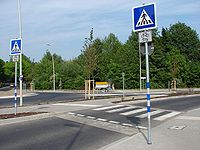Tag:crossing=marked
 |
| Description |
|---|
| A generic crossing with no traffic-signals of any type, just road markings. |
| Group: crossings |
| Used on these elements |
| Useful combination |
| Status: de facto |
| Tools for this tag |
This tag describes a pedestrian crossing that is marked but not controlled by traffic lights or people.
The type of marking can still be described explicitly with crossing:markings=*.
Another common way to map such crossings is to use crossing=uncontrolled.
A "de facto" alternative to crossing=uncontrolled : crossing=marked
Thecrossing=marked tag has been used for a long time and can still be used so it brings confusion, although it is not in iD presets anymore.
It is currently a "de facto" : the tag is in widespread use, and while it was not approved in a proposal process, it has a widespread acceptance among mappers :
| Tag | Definition | iD field | Taginfo statistics | |
|---|---|---|---|---|
| English | French | |||
crossing=marked
|
A generic crossing with road markings, but no traffic-signals of any type. | Feature Type = Marked Crossing
(does not show in iD presets) |
Type = Passage piéton non protégé
(n'apparaît pas dans les préréglages d'iD) |
|
Note that in the below discussion, it is explained that crossing=marked is not used anymore as a preset in iD, and therefore that crossing=uncontrolledis the official tag to use :
-> Should iD be tagging crossing=uncontrolled instead of crossing=marked?#408
Currently (January 2026), Taginfo shows about 2 250 000 nodes tagged with crossing=marked and a stagnation since 2022.
For comparison, crossing=uncontrolled has about 4 300 000 nodes and its use is growing fast :
| Tag | Definition | iD field | Taginfo statistics | |
|---|---|---|---|---|
| English | French | |||
crossing=uncontrolled
|
A generic crossing with road markings, but no traffic-signals of any type. | Feature Type = Marked Crossing | Type = Passage piéton non protégé | |
So despite the infamous misnomer, crossing=uncontrolled should be used instead of crossing=marked for new changes. Nevertheless, some local communities, especially English-speaking communities, continue to disfavor crossing=uncontrolled for this purpose, because it already referred to uncontrolled crossings (unmarked, unsignalized) long before the tag was redefined to mean a marked crossing, and conflating the two configurations renders the tag meaningless. To resolve this conflict, crossing:markings=* and crossing:signals=* are increasingly used in addition to or instead of crossing=*.
How to map
Set a node ![]() on the highway where the transition is and add
on the highway where the transition is and add highway=crossing + crossing=marked.
If the crossing is also mapped as a ![]() way, tag it as
way, tag it as highway=footway footway=crossing crossing=marked or highway=cycleway cycleway=crossing crossing=marked as appropriate.
Tags used in combination
tactile_paving=yes/no- Indicates whether a blind or visually impaired pedestrian can detect or follow the feature using a canecrossing:island=yes/no- Specifies whether a pedestrian crossing has a refuge islandcrossing:markings=*- The existence and style of pedestrian crossing markingscrossing_ref=*- Used to reference a specific type of crossing markingscrossing_ref=zebra- A zebra crossingbicycle=yes/no- if the crossing is expressly also to be used by cyclistslit=yes/no- Indicates whether a feature is lit.kerb=*- Used to indicate height and thus accessibility of a kerbwheelchair=*- Indicate if a special place can be used with wheelchairs
Software support
Editors
Starting from v2.12.0, released Dec 2018, iD described crossing=zebra as "outdated" and encouraged users to switch to crossing=marked + highway=crossing. This has attracted controversy.
This change was reverted in v2.17.0, released Dec 2019, due to ambiguity issues raised by mappers.[1]
Renderers
OsmAnd draws gray and white stripes along the crossing way and adds a pedestrian pictogram at the crossing node.
Straßenraumkarte Neukölln reserves a parking-free buffer zone around the crossing that is smaller than for crossing=zebra or crossing=traffic_signals. [1]
osm2streets (see AB Street) draws parallel white bars, as opposed to transverse white lines that denote crossing=unmarked.
Routers
OpenSidewalks converts crossing=marked to crossing:markings=yes. [2]
MOTIS Per Pedes Routing indicates whether the crossing is marked [3][4][5] and can calculate a detour that avoids unmarked, unsignalized crossings. [6]
Tagging schemes and tag growth evolution
Graphs of different schemes are shown on the following page link:
📈 https://taghistory.raifer.tech/#***/crossing_ref/zebra&***/crossing%3Amarkings/zebra&***/crossing/zebra&***/crossing/marked&***/crossing/uncontrolled&***/crossing/traffic_signals
The amount of objects increased exponential after implementation of an iD preset end of 2018 via v2.12.[2]
The growth of the amount of objects stopped immediately after implementation an update of iD preset end of 2022 via id-tagging-schema v5.10, see chart above (green line).[3]
See also
crossing=uncontrolled- A generic crossing with no traffic signals of any type, just road markings; e.g., zebra-crossings- Proposal: Proposed_features/crossing=marked